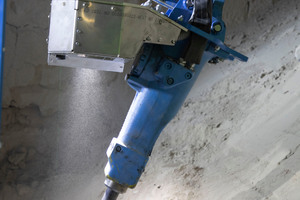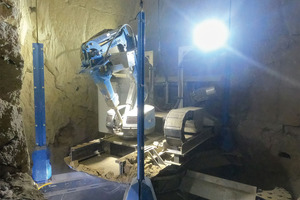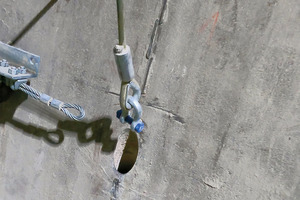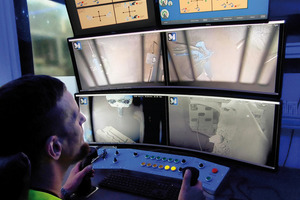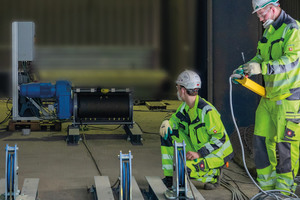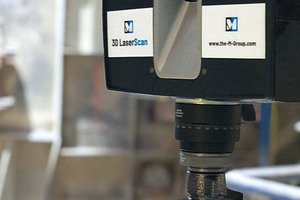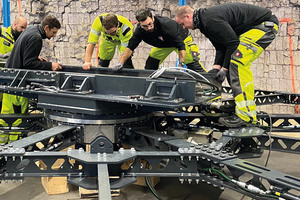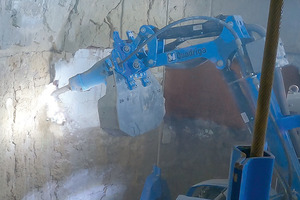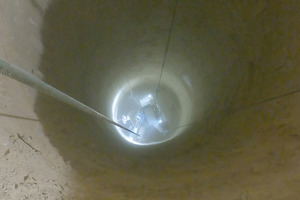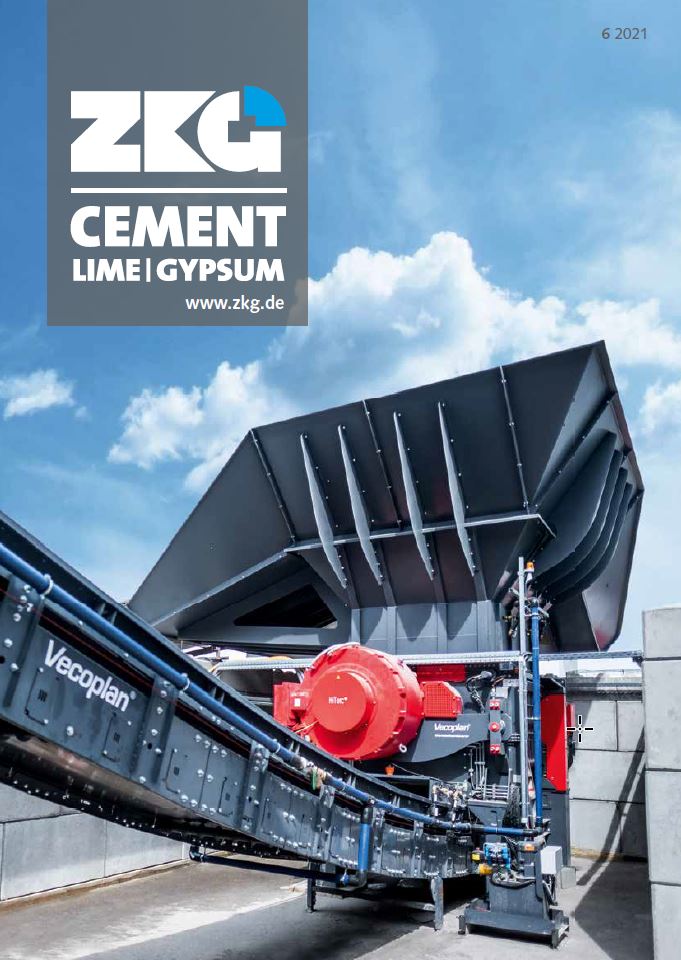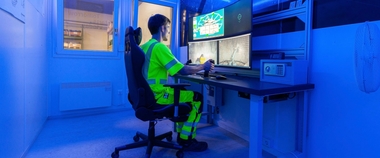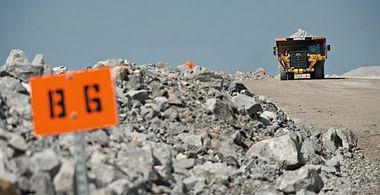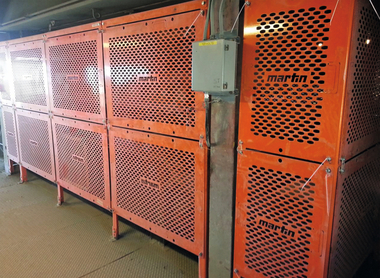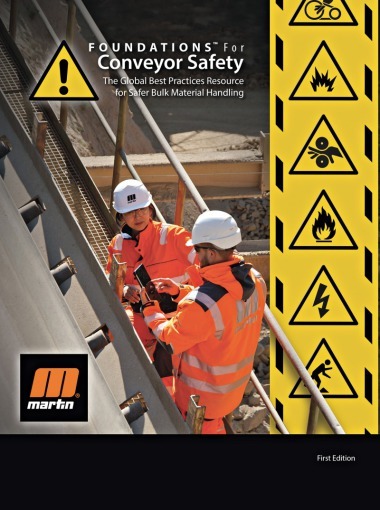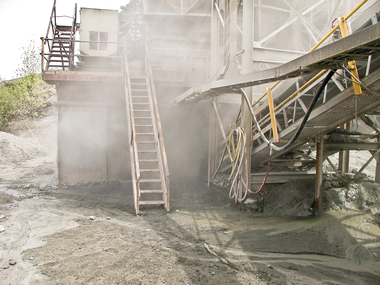The Quadriga robot system heralds a new era for safe lining demolition work as well as relining in vertical components
Maximum work safety combined with minimum personnel requirement and simultaneous minimization of downtimes as well as expansion of plant availability? These primary and undoubtedly competing plant overhaul objectives were the incentive for the M-Group (Möller Feuerfesttechnik, Eberhardt Schwab, RefraSolid, among others) to implement a novel development project for the overhaul activities in cylindrical components, e.g. the calciner of a cement plant.
Through Möller Feuerfesttechnik, the M-Group has been a reliable service provider with proven expertise for more than 50 years, and that not only in the cement industry. The other companies in the group offer know-how in plant engineering (Eberhardt Schwab) and safety engineering (RefraSolid) that is in demand worldwide. The profound know-ledge of the safety challenges of the industry, as well as comprehensive experience from different business areas, were used after approx. 1.5 years of development work to put the Quadriga system into operation for the first time in a German cement plant.
The focus was placed in particular on safety-relevant and digital aspects. The Quadriga system (worldwide patent pending) therefore has its own CE certification and is tested in accordance with the Machinery Directive and also certified for use of suspended access equipment by persons in accordance with DIN EN 1808.
The guiding principle in development of the system was the spatial separation of personnel and the component being inspected. This ensures that employees are protected from potential hazards (falling, various injuries, etc.) as well as the prevailing emissions (e.g. noise and dust) and thus from possible long-term harm. Thanks to the Quadriga, there is no longer the need for a scaffold erector to scaffold the component.
Following the successful initial operation, the necessary preparatory work and the individual components of the Quadriga system will be described now:
The preparations
The planning of the system setup and any necessary adjustments were carried out in advance by the M-Group. For this purpose, a comprehensive 3D scan of the plant (Figure 4) was first made. The aim was to obtain a realistic image which then served as a reference for further planning. In this way, feasibility studies and collision tests could be carried out, e.g. for the winch structure, the rope passage points or the installation angle through the enlarged manhole.
The result was a precise prediction of where a through-hole was necessary. The through-holes that were drilled were so small (Figure 2) that they could be closed by the supplied blanking plugs after dismantling of the system.
Another preparatory measure was the enlargement of the manhole. A manhole of at least 1.20 x 1.20 m is required in order to erect the platform including the demolition equipment inside the plant component.
The Quadriga system
The heart of the Quadriga, which combines proven industrial components in a completely new way, is a steel girder structure manufactured individually for the respective framework conditions (minimum diameter: 3.50 m), in the center of which a slewing ring is mounted. This is the basis for the currently possible areas of application: the lining demolition as well as the relining.
For the lining demolition, a classic industrial robot is mounted on the carriage. The robot can be moved around many different axes in order to reach the areas to be demolished with as little restriction as possible. Different types of chisels can be installed on the tool holder. While a design similar to a blade is recommended for the removal of deposits, a large pointed chisel is suitable for the lining demolition (Figure 1).
The platform hangs – depending on its diameter – on four to six winch cables, which are protected from damage by cable deflectors up to 2 m in height. In addition, another winch (called a support winch) is installed. The cable of this support winch enters the center of the component and facilitates the installation and removal of the system and can be used as a winch for material transport during the subsequent relining process. The winches, which each have a load-carrying capacity of two tons, are mounted on steel girders (Figure 5). In the application shown, these were connected to the existing ceiling girders of the building by means of girder clamps. Other attachment systems or solutions are possible on a customer-specific basis, depending on the given framework conditions.
The robot was additionally equipped with sophisticated camera technology, (infrared) spotlights, microphone and cross-line laser to achieve reliable remote control.
Various cameras allow different angles of view of the area of operation.
In order to provide ideal illumination, several spotlights were installed. These rotate when the slewing ring is actuated, thus ensuring uniform and, above all, consistent illumination. In the event of excessive dust exposure, infrared spotlights can be used as an alternative.
A microphone transmits the sounds to the ControlCenter. On the basis of the different sound frequencies, the QuadrigaPilot is able to determine whether the tip of the chisel is still on the refractory material or already on the steel shell.
Cross-line lasers assist him in gauging the distances between the tip of the chisel and the wall.
In demolition operation, the platform is supported by means of movable, hydraulic rams on the still existing deposit or refractory material and later on the steel shell. All movements are coordinated and generally monitored by means of a specially programmed PLC program. In addition, an operating unit ensures that all winches are controlled simultaneously. The entire system was inspected by external authorities and is CE-certified.
After the demolition had been completed within a very short time, the preparations for the new lining began. For this purpose, the demolition equipment was dismantled and instead tear plates were mounted as decking, including side protection around the outer edge of the platform. In addition to the existing load-bearing cables, safety cables were installed, which were attached to separate load suspension points by means of safety gear. In this way, the normative requirements of DIN EN 1808: “Safety requirements for suspended access equipment” were met.
After this equipment adaptation, the refractory bricklayers had a safe working platform from which the relining could be carried out.
The Quadriga system was controlled from the ControlCenter, which was located at ground level outside the danger zone next to the plant. This is where the QuadrigaPilot had his workplace and expertly controlled the various functions of the system by means of joysticks.
A wide variety of data could be displayed on the available monitor surface (see Figure 3). In addition to the live images from the cameras, messages concerning the status of the operating equipment (e.g. hydraulic oil temperature) were displayed.
In addition to the ControlCenter, an extra container was delivered for the storage of specific tools as well as critical components. This was a simple, space-saving and compact solution for the customer as well.
The training centre in Lemgo
In the lead-up to the first application, our experi-enced refractory professionals were intensively trained and prepared for the new technology. System setups, reconfigurations and dismantling were simulated and rehearsed in detail (Figure 6). A distinction is made between the QuadrigaPilots and the QuadrigaCrew. The crew ensures smooth assembly, reconfiguration and dismantling, while the QuadrigaPilots are responsible for operating the demolition robot using joysticks, camera control and acoustic features. At the end of the job, all the equipment is checked and serviced in the hall specially reserved for the Quadriga system.
Outlook
After the extremely successful conclusion of the first application (Figure 7), the system development work continues. The knowledge gained is being used directly for further developments. Further applications, such as concrete spraying, welding and automated bricklaying, are already in preparation. Intensive work is also already underway on an overhead-suspended lining demolition system.
Summary
Minimum personnel requirement combined with maximum occupational safety (Figure 8) with sim-ultaneous minimization of downtimes and general expansion of plant availability through professional work? This area of conflict involved in plant overhaul operations was the challenge that the M-Group accepted when it implemented a new type of development project that provides an answer to the most urgent requirements of many industries.

